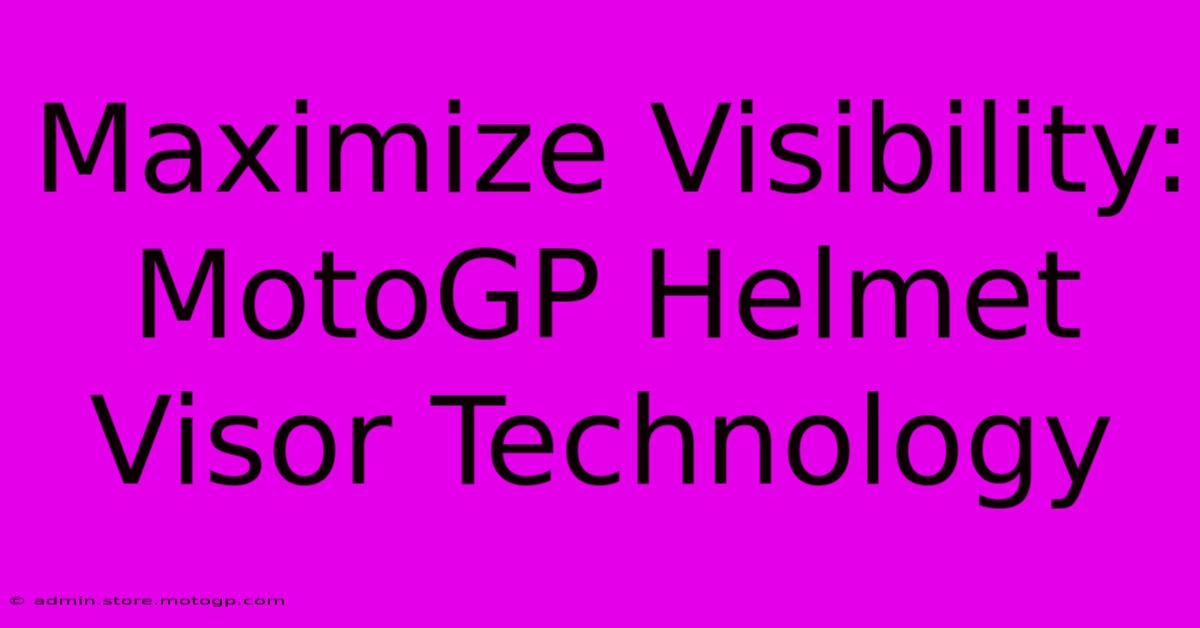Maximize Visibility: MotoGP Helmet Visor Technology

Table of Contents
Maximize Visibility: MotoGP Helmet Visor Technology
MotoGP racing pushes the boundaries of speed and skill, demanding peak performance from every piece of equipment. The rider's helmet, a crucial piece of safety gear, is constantly evolving, and a key area of development lies in the visor technology. Maximizing visibility is paramount for rider safety and competitive advantage, and advancements in visor technology play a critical role. This article delves into the cutting-edge technologies used in MotoGP helmet visors, exploring how they enhance clarity, reduce glare, and improve overall rider performance.
The Importance of Optimal Visibility in MotoGP
In the high-stakes world of MotoGP, even a fraction of a second can make the difference between victory and defeat. Optimal visibility isn't just about seeing the track; it's about anticipating other riders' movements, judging braking points, and reacting instantly to changing conditions. Poor visibility can lead to dangerous situations and compromised performance.
Factors Affecting Visibility:
- Sunlight: Direct sunlight and reflections can significantly impair a rider's vision, especially on bright race days.
- Weather Conditions: Rain, fog, and dust can severely reduce visibility, demanding enhanced optical clarity.
- Speed: The extreme speeds in MotoGP magnify the impact of even minor visual impairments.
- Track Conditions: Understanding the track surface, tire grip, and potential hazards requires clear, unobstructed vision.
State-of-the-Art Visor Technologies in MotoGP
Manufacturers continuously innovate to address these challenges, resulting in several advanced visor technologies:
1. Anti-Fog & Anti-Scratch Coatings:
Pinlock Inserts: These are the industry standard for anti-fog protection. A secondary, smaller visor sits within the main visor, creating an air gap that prevents condensation. This is crucial in humid conditions or when transitioning between cold and warm environments.
Anti-Scratch Coatings: High-quality helmets feature advanced coatings that resist scratching and abrasion from dust, debris, or even the rider's visor wipe. Maintaining optical clarity is vital, and these coatings significantly extend the visor's lifespan and performance.
2. Improved Optical Clarity:
Polycarbonate Construction: Most MotoGP visors are made from high-quality polycarbonate, offering excellent impact resistance and optical clarity. The material's inherent qualities minimize distortion, providing a clear and undistorted view of the track.
Precision Manufacturing: The manufacturing process plays a critical role in ensuring perfect optical properties. Advanced techniques minimize imperfections, leading to superior visual clarity and reducing eye strain during long races.
3. Light Management Technologies:
Iridium Coatings: These coatings reduce glare and enhance contrast by selectively filtering specific wavelengths of light. This is particularly beneficial on bright sunny days, improving rider comfort and reducing eye fatigue.
Photochromic Visors: These advanced visors automatically adjust their tint based on ambient light conditions. They darken in bright sunlight and lighten in low-light conditions, providing optimal visibility in varying lighting scenarios. This dynamic adaptation is a significant advantage for races held in different times of day.
4. Tear-Off Systems:
Tear-Off Films: These thin, disposable films are applied to the visor's exterior and easily peeled off when dirty or scratched. This allows riders to maintain clear vision, especially in wet or dusty conditions, crucial for maintaining focus and safety.
Conclusion: The Pursuit of Perfect Visibility
The relentless pursuit of perfect visibility in MotoGP showcases the commitment to rider safety and performance. The continuous advancements in visor technology underscore the importance of even seemingly small details in this high-octane sport. From anti-fog and anti-scratch coatings to iridium and photochromic technologies, these innovations contribute to a safer and more competitive racing environment. As technology progresses, expect to see even more sophisticated visor solutions that further optimize rider performance and safety in the future of MotoGP.

Thank you for visiting our website wich cover about Maximize Visibility: MotoGP Helmet Visor Technology. We hope the information provided has been useful to you. Feel free to contact us if you have any questions or need further assistance. See you next time and dont miss to bookmark.
Featured Posts
-
Qualifying Results In Moto Gp Grid Positions Confirmed
Feb 20, 2025
-
Cota Open Track Days Your Gateway To Racing
Feb 20, 2025
-
Top Speed Moto Gp Bike Feel The Adrenaline Rush
Feb 20, 2025
-
Yamaha Moto Gp News Live Updates
Feb 20, 2025
-
Moto Gp 23 Ps 5 Get In The Drivers Seat
Feb 20, 2025
